Description of diseases and pests of cucumbers in the greenhouse

Many gardeners are faced with a problem such as cucumber disease. Currently, there are a large number of different infections that can affect this culture. Today we will talk about what diseases cucumbers most often suffer in the greenhouse, and how to deal with them.
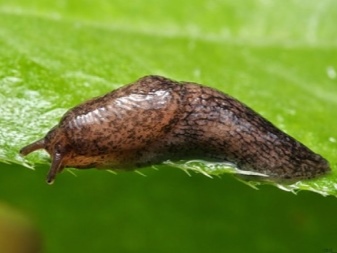

Diseases and their treatment
Next, we will analyze the description, main signs, features of various diseases of these plants. They come in different types, most often cucumber bushes suffer from fungal and bacterial infections.
Anthracnose
Anthracosis is also called copperhead. It is caused by a fungus and is considered a rather dangerous viral infection in which stems, fruits and foliage are affected. Leaves and stem are gradually covered with yellow spots. Over time, these areas begin to grow.
The affected areas dry out and fall off, forming holes in the leaves. On the fruits, brown and pink oblong spots are formed. They can be of various sizes. There are different methods of dealing with anthracnose. To cure vegetation, it is best to use ready-made antifungal drugs: Fitosporin, Topaz, Poliram.
Treatment with such agents is recommended to be carried out in protective clothing and a mask.
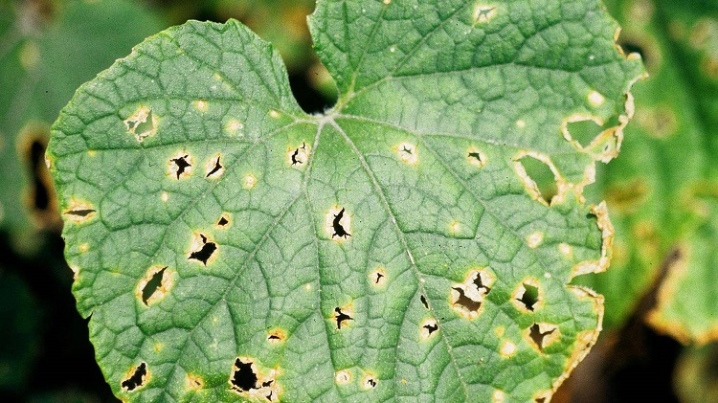
Peronosporosis
This fungal infection disrupts the process of photosynthesis in plants, resulting in rapid death.... Peronosporosis can appear at any stage of growth. It is transmitted by air. The disease primarily affects the leaves. Spots of various shapes appear on them. They are most often green-yellow in color.
On the reverse side of the leaf plates, a bloom of purple or gray-white color appears. Gradually the spots grow. They begin to connect with each other. As a result, the leaf turns completely yellow and dries up. To combat this disease, chemical fungicides may be suitable. So, you can use "Profit", "Ridomil", "Fitosporin M".
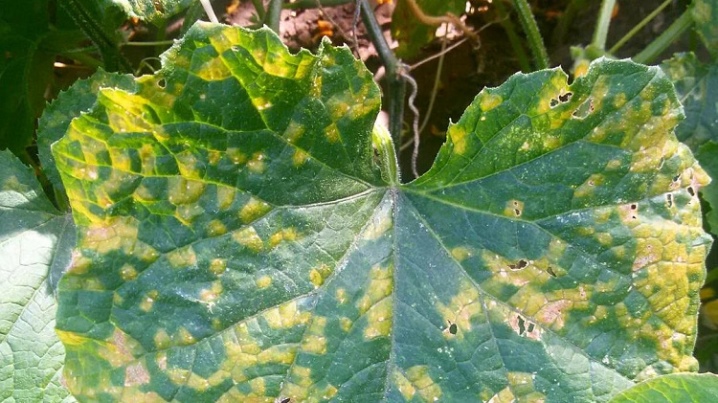
Fusarium wilting
This disease often affects greenhouse cucumbers. At the same time, the vegetation becomes sluggish, the leaves hang down. Most often this occurs due to damage to the vascular system of plants by a harmful fungus. But sometimes wilting can occur due to overly dense soil.
Over time, the shrubs begin to lose their rich bright color, they become pale and weak. A bloom of pink color appears on the root zone. If the plant is not started to heal in time, it will simply die. To combat this disease, it is best to use the chemicals "Integral", "Planriz".
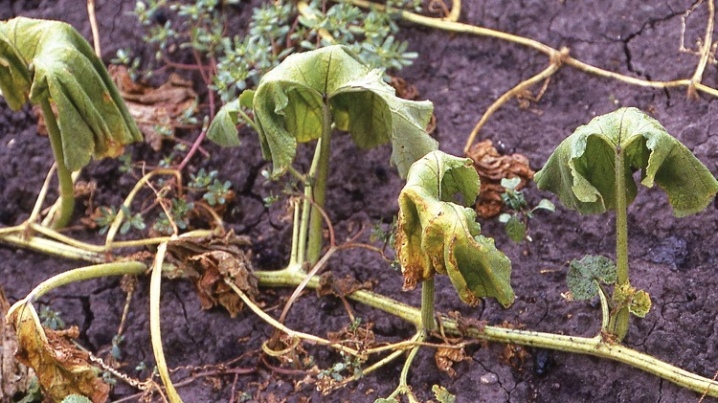
Ascochitosis
This disease is also fungal. It can be transmitted both through the air and through the soil. It usually occurs during the ripening period of the fruit. In this case, the edges of the leaf plates are covered with gray spots, they gradually spread over the entire surface of the foliage. And also on the affected areas, blotches of a dark color may appear. After that, the harmful fungus begins to damage the stem and roots. The vegetables will darken and will be unusable.
In order to destroy ascochitosis, bacteriological ready-made preparations, including Trichodermin and Fitosporin, can be used. In the initial stages, cucumbers can be cured with simple folk remedies.
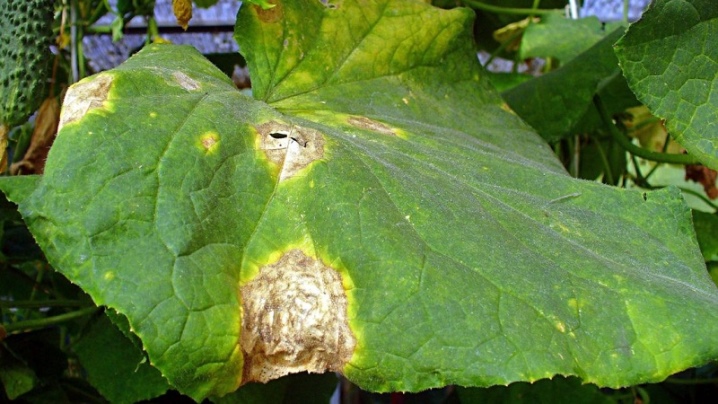
Bacteriosis
This disease is also called angular spotting. It is viral. Carriers can be both humans and insects, as well as rain and wind. Bacteriosis is actively developing in conditions of high temperature and high humidity. The plant can be affected at any stage of growth. At the same time, a large number of small angular spots of yellow color appear on the vegetation. Over time, they begin to darken, acquire a brown color. Mucus forms on the back of the foliage.
Further, the affected parts dry out and fall off, as a result of which only veins remain. Cucumbers stop bearing fruit and die quickly. To cure a culture, you first need to reduce humidity levels... All affected areas are removed. After that, treatment with drugs is carried out. Moreover, it is better to use insecticides and fungicides at the same time in order to achieve maximum effect. The best option will be funds "Kuproksat", "Actellik", "Fitolavin", "Baylon".

Cladosporium
The disease is also called olive brown spot. It is viral fungal. Cladosporia is usually caused by excessive moisture levels. Brown spots with yellow edges are formed on the foliage between the veins.
Gradually, they become covered with bloom. The fungus can quickly take over the entire plant. Over time, it affects the fruits, they become irregular, covered with spots of olive shade. To cure cucumbers, you can use the drug "Oxyhom".
During the season, you need to carry out 3-4 treatments at intervals of 10-13 days.

Root rot
This fungal disease occurs due to excessive moisture. It affects the root system of vegetation, which leads to its early death. It is quite difficult to recognize rot in the initial stages. In case of defeat, the base of the stem will become thinner, a bloom of a yellow tint will appear in the same place. Cracks will begin to form on the central shoot. On the surface of the earth, you can see softened brown roots.
The lower leaf plates become lethargic, as a result, the plant stops developing and dies. Chemical pesticides (Previkur) should be used to combat root rot. After five days, the cucumbers should be watered with a solution with the preparation "Fitolavin" (for 10 liters of water, 20 milliliters of substance). To restore the soil after such chemicals, you can use the remedy "Gamair".
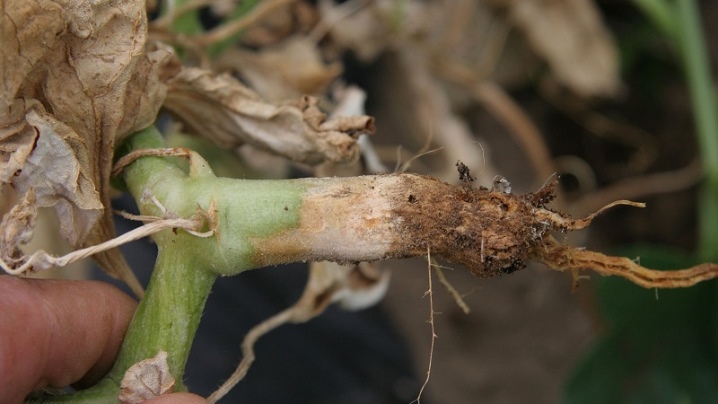
Sclerotinia
The disease is also called white rot. It is caused by a fungus that appears due to high levels of humidity. The upper part of the plant begins to wilt, and the process of decay occurs in the lower part of the stem.
The leaves lose their rich color, become watery. Over time, the entire bush becomes covered with a bloom of white. As a result, the cucumbers die completely. All damaged parts are required cut and burned. After that, it is necessary to carry out the processing of the culture with chemical preparations "Profit Gold" or "Hom".
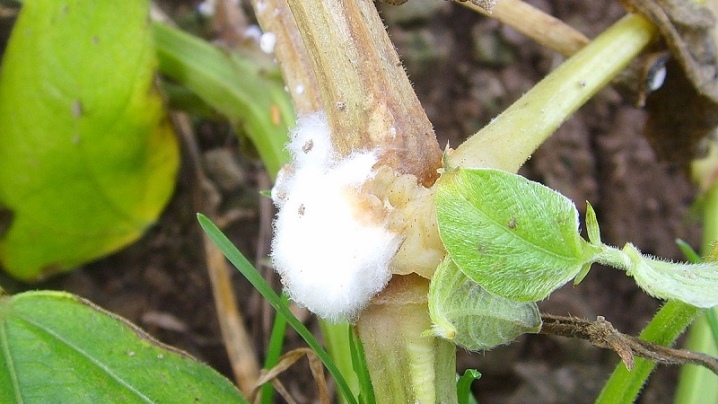
Gray rot
This fungal disease affects the leaves. A large number of brown spots appear on their surface. Then they are covered with a bloom of gray. The plant begins to rot, and then dies.
Gray rot requires complex complex treatment. All affected parts are immediately removed and incinerated. Then, the damaged cucumbers are thoroughly processed with chemical and biological compounds. You can use the drugs "Koniotirin", "Hom", "Trichodermin". Moreover, spraying should be carried out either late in the evening or early in the morning.
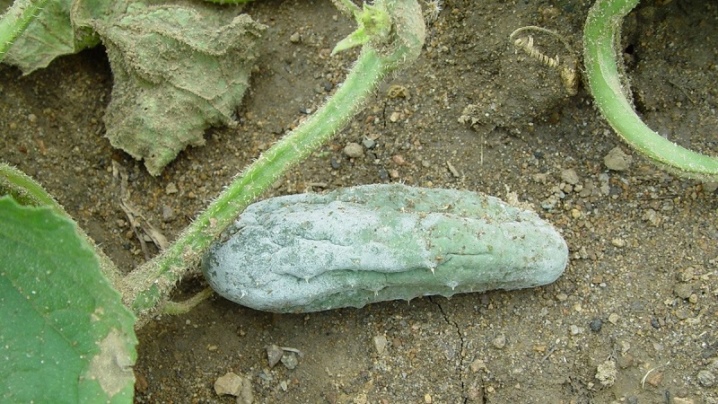
Mosaic
Such a dangerous viral disease can develop as quickly as possible. The main vector is aphids. Dark and light spots will appear on the foliage, which will resemble a mosaic picture.
Further, the leaves are deformed, their surface becomes bumpy. Bushes lose their rich color and die. In case of defeat, you can use homemade folk remedies. A solution with tar soap would be an excellent option.... It is necessary to dissolve a large piece of such soap in 10 liters of clean water. Spraying is performed with the finished composition.
The procedure must be repeated several times at short intervals.
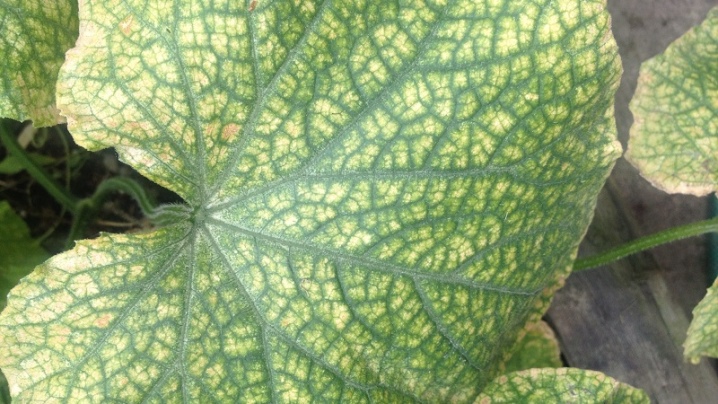
Powdery mildew
This fungal infection can spread quite quickly throughout the vegetation. Small spots of white appear on the cucumber leaves. They get bigger over time. The foliage gradually curls up and dries up.
Then the fungus will take over the fruits and stems of the cucumbers. An active process of decay will begin, after which the vegetation will die. To combat powdery mildew, you can use biological preparations: "Topaz", "Bayleton".
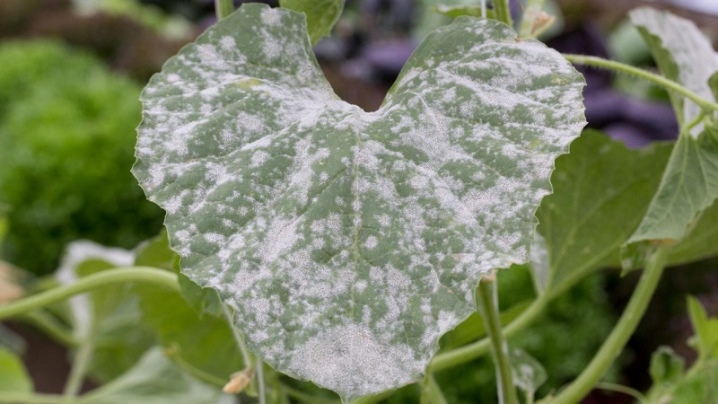
Pests and the fight against them
Cucumbers are often affected by various pests.
- Aphid... This parasite often infects cucumbers. Aphids are small sucking insects. As a rule, whole colonies can be seen on plants at once. The pest can appear on the crop at the beginning of summer. It feeds on the juices of vegetation, which is why it begins to wither quickly, weaken and slow down in development. The veins on the leaves change their color, the foliage will begin to curl and dry out, the stems may bend. To get rid of aphids, you can use various folk remedies. The best option would be infusions prepared on the basis of onion peel, dandelion, wood ash. Moreover, for greater efficiency, the composition should be diluted with crushed laundry soap. Remember that it is also necessary to timely destroy ants, which are the main carriers of aphids.
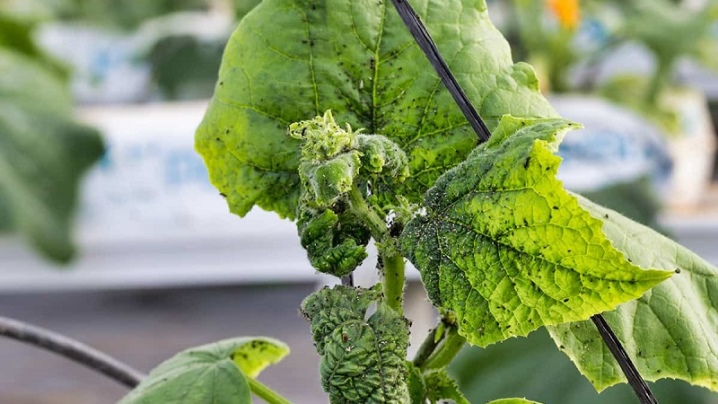
- Whitefly... Such a parasite behaves in much the same way as aphids. The whitefly lives in entire colonies on the lower part of the foliage. She feeds on plant juices, which is why white spots appear on it, then the leaves begin to curl, dry and fall off. In addition, the pest secretes a special sweet liquid that can also harm the bushes. It promotes the appearance of powdery mildew and gray rot on vegetation. To get rid of the parasite, you should also process cucumbers with folk remedies. The best option would be a solution with laundry soap and clean water (in proportions 1: 6). And you can also hang special glue traps in polycarbonate greenhouses. Sometimes ready-made preparations are immediately used: "Iskra", "Actellik", "Biovert", they allow you to quickly remove the whitefly.
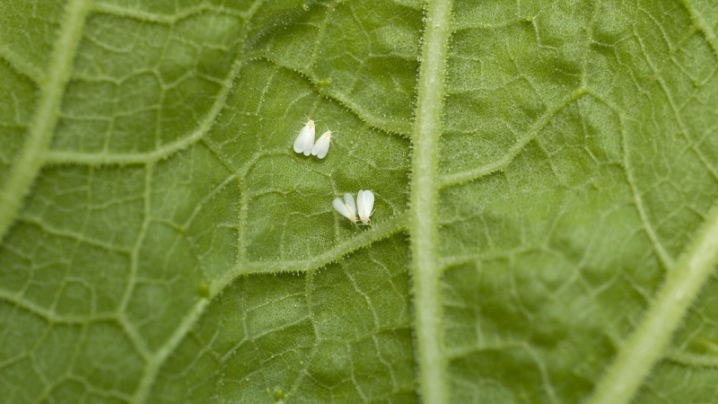
- Spider mite. The insect leaves a thin white web on the plant. In addition, it actively sucks out all the juices from the cucumbers. The foliage is covered with spots of a light shade. Then it completely turns yellow, dries up and falls off. Most often, spider mites appear in dry weather with high temperatures. To combat such a pest, it is best to use ready-made insecticides: Karbofos, Akarin. The affected plants are treated by spraying. Often, gardeners sprinkle cucumbers with folk remedies prepared with laundry soap, garlic or onion peels.

- Thrips... Insects hide in leaves and buds. They gradually suck out all the juices from the culture. Thrips can fly all over the site and damage other plantings. When damaged, a huge number of small spots of white-gray color will appear on the foliage. They grow and merge with each other, then darken and fall off, forming holes of various sizes. Vegetation slows down greatly in growth, begins to bear fruit poorly. Ripe vegetables will be irregular in shape. To get rid of thrips, it is worth treating with chemical insecticides: Confidor, Fitoverm, Aktellik, Iskra. And also a good option would be to place glue traps in the greenhouse.
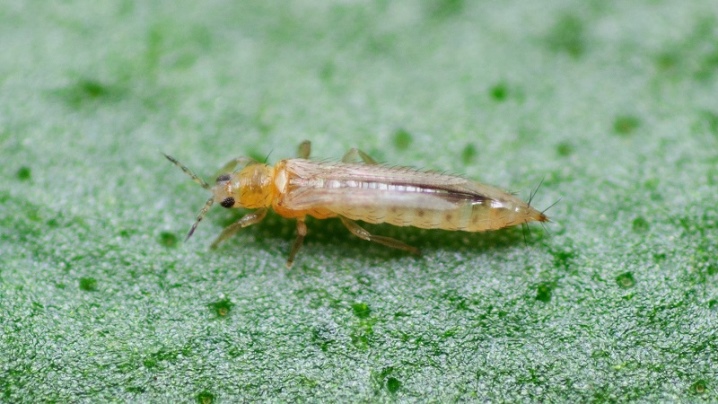
- Wireworm... The pest feeds on the roots of cucumbers. In this case, the use of chemicals will be absolutely useless.When a wireworm appears, thorough loosening of the near-trunk area should be carried out, this will remove pests. In the fall, it is worth carrying out a deep digging of the soil, this will help to destroy the larvae. You can process vegetation with folk remedies. And it is also recommended to apply fertilizers with nitrogen, wood ash, they prevent the reappearance of the wireworm.
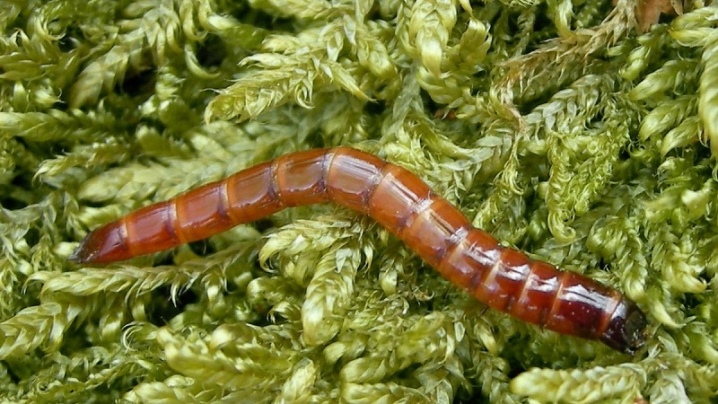
- Slugs... The main reason for the appearance of these harmful molluscs on cucumbers is high humidity. Slugs eat young plants, which causes them to weaken and die. To get rid of them, you can place parsley, cilantro, pepper between the cucumber rows, they scare away the parasite. A more effective way of fighting will be the use of chemicals: "Ferramol", "Sludge-eater", "Etisso". Instead of them, special dressings are sometimes used, which contain calcium. In any case, it is necessary to make a medical solution in strict accordance with the instructions.
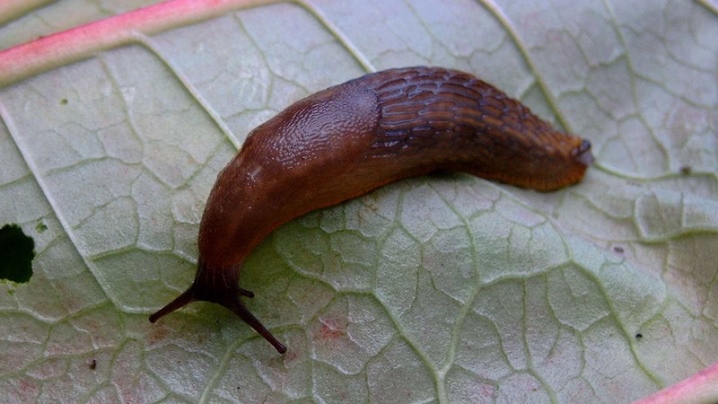
- Medvedka... Such a large insect can reach a length of 6-8 centimeters. It can destroy most of the plantings on the site in a short time. Most often, when a bear appears, whole moves appear on the soil. It is permissible to fight it both with folk remedies and with chemicals. In the first case, it is better to prepare a medicinal solution with crushed laundry soap and washing powder. The resulting substance is poured into the burrows. In the second case, you should take drugs such as Boverin, Thunder, Prestige, Aktara.
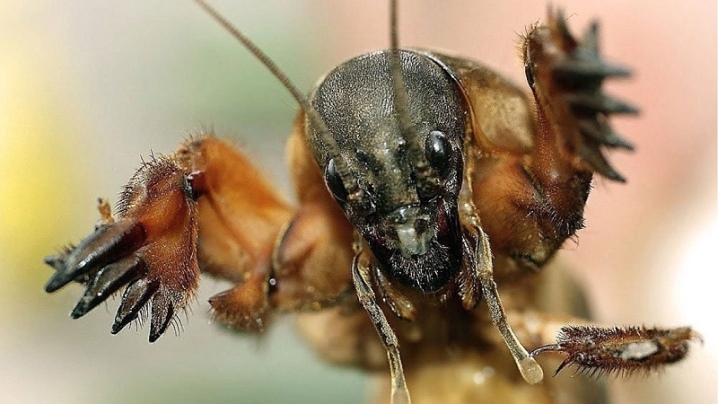
- Gall nematodes. These small white worms reach a length of no more than 2 mm. Most often they appear when the humidity is too high. Gall nematodes live in the soil and through it infect cucumbers. Shoots and foliage curl, roots become weak and too thin. Plant growth is greatly slowed down. Further, the pest impairs metabolic processes in plants, they cannot receive all the necessary nutritional components. To cure the affected culture, you should purchase the drugs "Phosphamide", "Mercaptophos". And also some gardeners dig out bushes and dip them into heated water, at temperatures over 40 degrees Celsius, nematodes quickly die.
Cucumbers are often damaged by rodents. Mice and rats easily eat up the root systems and ripe fruits of the culture. And they are also carriers of many dangerous diseases. To destroy them, it is better to immediately use drugs: "Mortorat", "Goliath", "Krysid".
Sometimes gardeners place elderberry branches on their site, they scare away rodents.
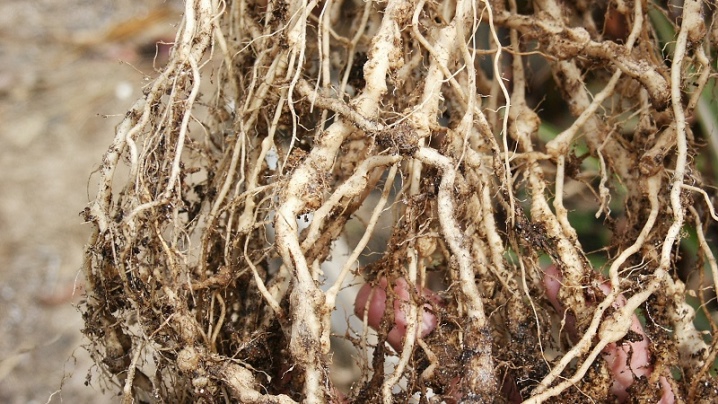
Prevention measures
To protect cucumbers from various diseases and pests, it is worth taking timely preventive measures. Before planting cucumber seeds, you should carefully inspect them for damage. If there are infected seeds, they are immediately destroyed. And also immediately before planting, seed material and seedlings are recommended to be treated with disinfectants and fungicides.
Remember that different harmful organisms can live in the garden soil, so the soil must be prepared before planting... To do this, the land is treated with a composition with lime or a special store solution. You should not plant cucumbers in the same place for several years in a row. Before planting, it is recommended to disinfect the entire greenhouse or greenhouse. Do not forget that after planting, the cucumber beds must be weeded regularly, the soil must be loosened, and fertilized must be applied. Do not water the bushes too much, as this can lead to the development of fungal infections. Watering is performed only at the root, you cannot pour water on the plants themselves.
Many gardeners advise doing preventive treatments with biological preparations. For this, the best are the "Alirin-B", "Glyokladin", "Trichocin" means. They help protect vegetation from wilting, root rot, powdery mildew and anthracnose.Sometimes, to prevent diseases, the bushes are sprayed with solutions with chemical fungicides, which contain copper. The most popular options are Bordeaux liquid and Hom, which will provide reliable protection for cucumber bushes.
Any disease in a greenhouse structure can easily destroy all plantings in it, therefore, if infected plants are found, appropriate measures must be taken immediately so as not to lose the entire crop.


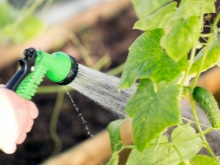













The comment was sent successfully.